FAS |
Military |
DOD 101 |
Systems |
Aircraft |
ROW ||||
Index |
Search |
Join FAS




TORNADO (BAe)
Designed and built as a collaborative project in the UK, Germany and Italy, the Tornado is in service with all three air forces and the German Navy. Tornado is also in service in Saudi Arabia and Oman. It is a twin-seat, twin-engined, variable geometry aircraft and is supersonic at all altitudes. The design authority for the Tornado is Panavia, the tri-national consortium which comprises British Aerospace, DASA of Germany and the Italian firm Alenia.The wings of the the aircraft are high-mounted, variable, swept-back, and tapered with angular, blunt tips. There are two turbofan engines inside the body. The air intakes are diagonal and box-like alongside the fuselage forward of the wing roots. There are twin exhausts. The fuselage is solid and has a needle nose. The body thickens midsection and tapers to the tail section. There is a bubble cockpit. The tail is tall, swept-back, and has a tapered fin with a curved tip and a step in the leading edge. The flats are large, mid-mounted on the body, swept-back, and tapered with blunt tips.
The Tornado GR1 strike/attack aircraft is capable of carrying a wide range of conventional stores, including the JP233 anti-airfield weapon, the ALARM anti-radar missile, and laser-guided bombs. The reconnaissance version, designated the GR1A, retains the full operational capability of the GR1. The GR1B, equipped with Sea Eagle air-to-surface missiles, undertakes the anti-surface shipping role. For self-defence, the Tornado carries Sidewinder air-to-air missiles and is fitted with twin internal 27mm cannons.
The GR1 originated from a UK Staff Requirement in 1969, calling for a medium-range, low-level, counter-air strike aircraft, with the further capabilities of interdiction and reconnaissance. The Tornado first saw action during the Gulf conflict of 1991, when several were lost as a result of daring ultra-low-level missions to close Iraqi airfields. The proliferation of anti-aircraft defences in Iraq, Bosnia and elsewhere that the UK might be called on to operate has meant that the standard GR1 is in danger of not being able to fulfil the covert deep penetration operations that it was designed for. Furthermore the advance of air-delivered weapons has meant that strike aircraft need to become ever more sophisticated, especially given the fears of �collateral damage� or accidentally hitting civilian targets.
The Tornado F3 air defence fighter has an 80% commonality with the Tornado GR1 strike/attack aircraft. The Tornado F3 is optimised for long-range interception, for which it carries four Skyflash radar-guided missiles and four AIM 9-L Sidewinder infra-red homing air-to-air missiles, plus an internally-mounted 27mm Mauser cannon. Tornado F3s are being equipped with the new Joint Tactical Information Distribution System. Operating in conjunction with E-3D Sentry airborne early warning aircraft and other allied fighters, the system gives an unprecedented picture of the air battle, including information obtained by other sensors in other fighters or AEW aircraft. The crew can thus select its own target and move to within 'kill' distance without using the fighter's own search radar with its position-revealing signature until the very last moment. The Tornado GR1A is a world leader in the field of all-weather, day and night tactical reconnaissance. The GR1A has no cannons mounted in the forward fuselage. Replacing these are a Sideways Looking Infra-Red system and a Linescan infra-red surveillance system.Originally intended for use in Central Europe, interdicting Warsaw Pact armoured columns and operating in the counter-air role against enemy airfields, the GR1 is now facing a more challenging future, with improved air defences to face and more difficult targets to engage. The GR1 Mid-Life Update (MLU) is intended to enhance the capabilities of many of the GR1 fleet, allowing a wider range of missions in all weathers and permitting the use of the advanced, so-called �smart� munitions now available. The new version will be known as the Tornado GR4.
A mid-life update program was completed by the end of 1998 which, as well as enhancing survivability and operational effectiveness, to give the aircraft the capability to carry advanced weapons such as the anti-armor weapon 'Brimstone' and the stand-off attack missile 'Storm Shadow'. The updated aircraft is designated Tornado GR4. The last of the updates is scheduled for early 2003. The MLU will allow the RAF�s Tornados to serve well into the next century until they are eventually replaced by the Future Offensive Air System (FOAS). The airframe�s life is to be extended as a result of more advanced technology and this will avoid the necessity of expensive refits or the acquisition of new aircraft.
Both offensive and defensive capabilities will be enhanced on the GR4, including a new Forward-Looking Infra Red (FLIR) system and Night Vision Goggles (NVG), laser designation facilities to allow the precision bombing that characterised the recent Gulf conflicts, plus a Defensive Aids sub-system to protect the aircraft from Surface to Air Missiles and radar-directed anti-aircraft guns. New avionics improve navigation and flight performance, including the installation of a Global Positioning System. In addition to the existing range of weaponry, such as laser-guided bombs and anti-radar missiles, the GR4 will be able to operate new and development equipment such as the Storm Shadow stand-off attack missile.
The GR4s will all be capable of using the Sea Eagle anti-shipping missile, whereas only the relatively small numbers of Tornado GR1Bs are presently fitted for maritime strike. The actual payload, speed, altitude and other performance characteristics of the GR4 will remain much the same as for the GR1. What will change, however, is the overall capability of the aircraft. The ability - literally - to see in the dark when using FLIR and NVG will permit GR4s to fly at terrain-following height, in close formation, without navigation lights or radar emissions. In effect the GR4 is a more stealthy aircraft, enhancing its chances of covert deep penetration and surviving the mission. It is now an all-weather strike aircraft, an important factor in Europe.
The overall cost of the Tornado MLU is currently estimated to be �850 million. The first delivery was achieved on time on 31 October 1997 and the aircraft formally entered service on 30 September 1998. As of February 1999, 26 GR4s had been delivered to the RAF, from a total number of 142 planned updates. Thirty-two of this number will be training variants, capable of the range of missions that the standard GR4s carry out, but fitted with dual flight controls. Some 26 GR4s will be designated GR4A, being dedicated reconnaissance aircraft equipped with sophisticated equipment built into the airframe. Since only the RAF currently intends operating GR4, the actual MLU work is undertaken within the UK. The RAF at St Athan in Wales carries out preliminary work and then the main conversion is undertaken at BAe Warton in Lancashire.
Specifications | |
| Country | Germany, Italy, United Kingdom |
| Manufacturer | Panavia Aircraft GmbH, Am S�ldnermoos 17, 85399
Hallbergmoos, Germany Phone: 0049/811/801238, Fax: 0049/811/801386 |
| Crew | Pilot, WSO |
| Armament | Two internal 27-mm Mauser cannon with 180 rounds per
gun plus more than 9000 kg of external stores on seven hardpoints, including Sidewinder Texas Instruments HARM Hughes AGM-65 Maverick British Aerospace ALARM Laser guided bombs like Paveway Bombs up to 450 kg MW-1 munitions dispenser Matra Apache Nuclear freefall bombs |
| Power plant | 2 x Turbo-Union RB199-34R turbofans Thrust: 38,7 kN (8700 lbs) dry and 66 kN (14480 lbs) with afterburner |
| Dimensions | Length: 16,72 m Height: 5,95 m Span: 13,91 m fully forward, 8,60 m fully swept Wing area: 26,6 sqm |
| Weights | Empty weight: approx. 13890 kg Max. external load: over 9000 kg Max. fuel: 4660 kg (5100 kg in RAF and Saudi AF aircraft) Max. take-off weigth: approx. 28000 kg |
| Performance |
Max. speed : 1,452mph (2,336km/h) at 36,000ft (11,000m) Max. speed : Mach 2.2 at altitude Max. speed with external stores: Mach 0.92 (1110 km/h) Rate of climb: Time to 30000 ft (9150 m) less than 2 min Take-off field length: 900 m or less Landing run: 370 m Ferry range: approx. 3900 km Radius of action: 1390 km (750 NM) with heavy load, hi-lo-lo-hi g-limit (g-Limit): + 7,5 |
| Customers | The IDS (interdictor-strike) version of Tornado is in service with the Royal Air Force, Luftwaffe, German Navy, Italian Air Force and Royal Saudi Air Force. |
| VRML 3-D Model | |
 Tornado Wings Swept back VRML by Soji Yamakawa |
 Tornado Wings Spread VRML by Soji Yamakawa |
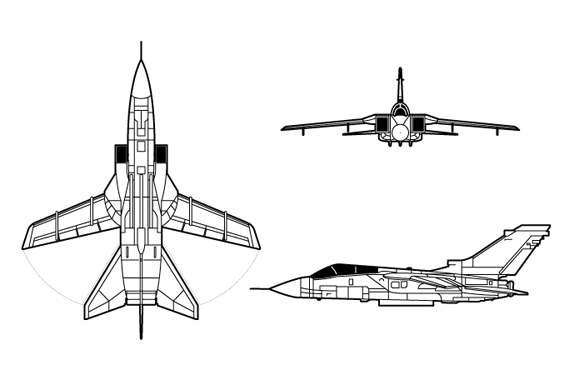
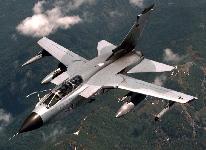
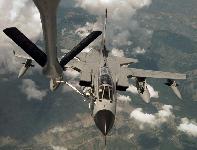


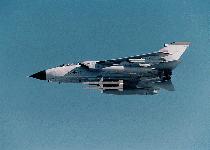

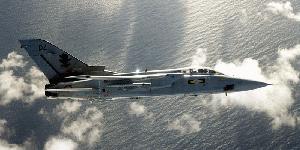
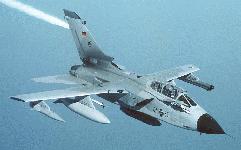
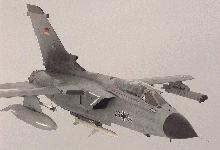
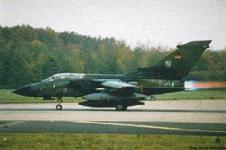

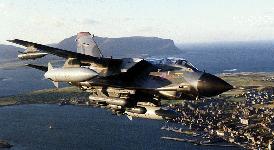



Sources and Resources
FAS |
Military |
DOD 101 |
Systems |
Aircraft |
ROW ||||
Index |
Search |
Join FAS
http://www.fas.org/man/dod-101/sys/ac/row/tornado.htm
Maintained by Robert Sherman
Originally created by John Pike
Updated Thursday, March 11, 1999 7:47:49 PM